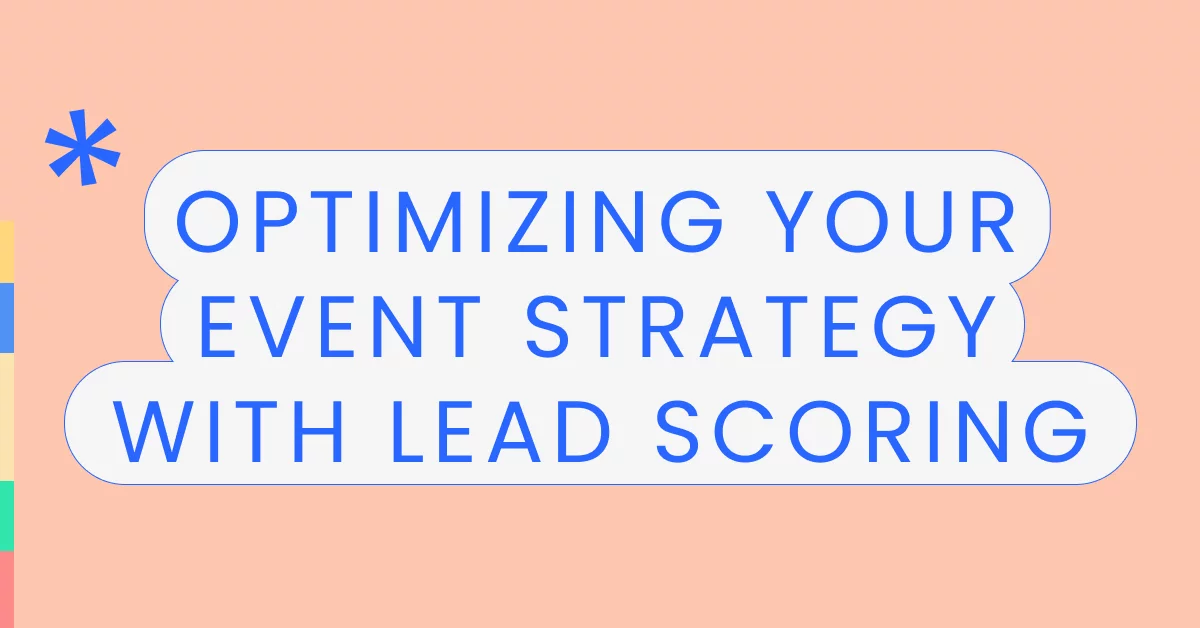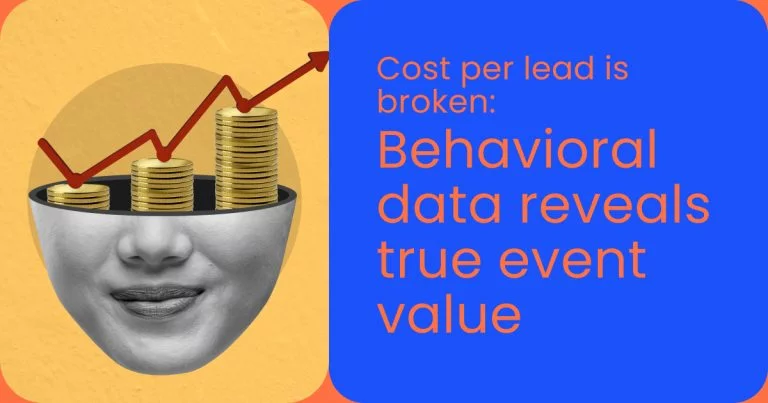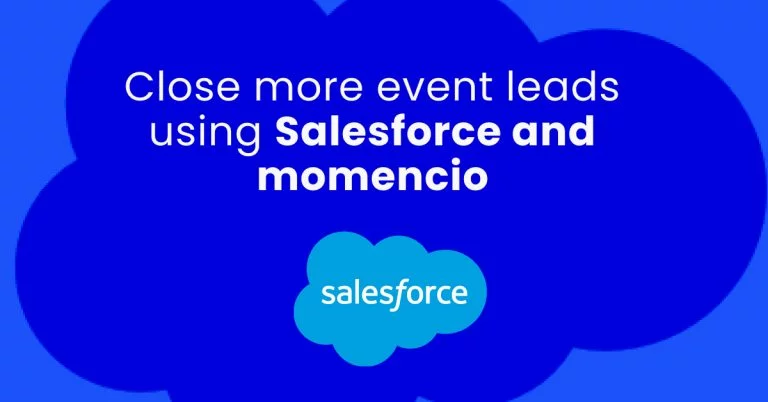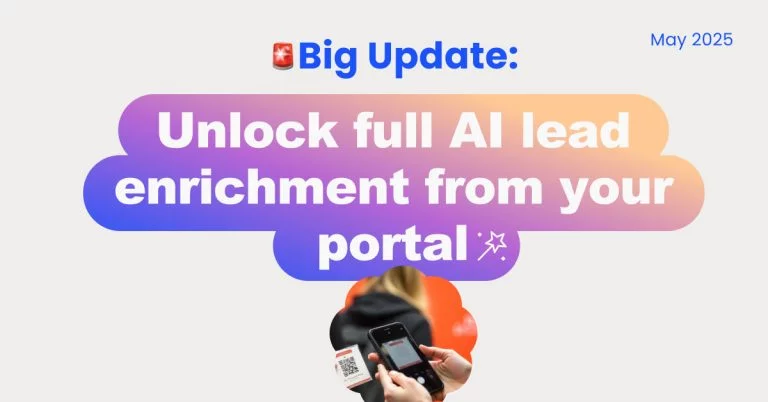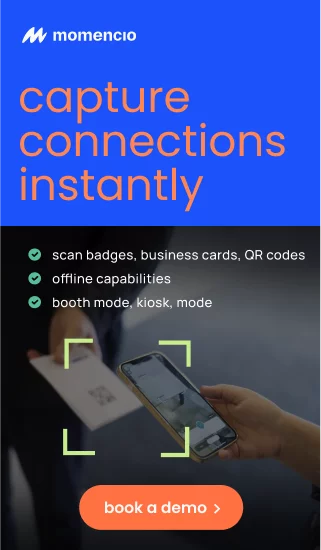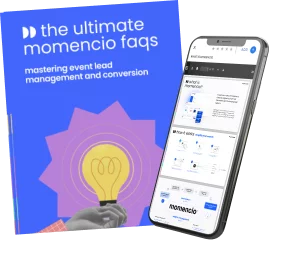Lead scoring is a powerful strategy that businesses can leverage to prioritize and manage event leads effectively. According to the latest reports, only 27% of leads generated by marketing are qualified for direct sales contact. This underscores the critical need for an effective lead scoring system to identify the most promising leads efficiently.
TL;DR: Lead scoring optimizes event strategies by allowing you to segment attendees, prioritize high-potential leads, and tailor engagement based on their scores. It helps in making real-time adjustments during the event and refines future strategies by analyzing post-event lead data, ensuring more effective and targeted outcomes.
Before we move into understanding what lead scoring is and how it can help your business, we need to understand what event marketing strategy means for your business.
What is meant by event marketing strategy?
Put simply, an event marketing strategy is a plan that businesses use to promote their products, services, or brand through events. It involves organizing or participating in events, like trade shows, conferences, webinars, or product launches, to connect with potential customers, build relationships, and create brand awareness.
The goal is simple – use the event to showcase your value, engage directly with your audience, and turn those interactions into sales or lasting customer relationships. It’s about making a memorable impact while reaching your target audience in a focused, interactive setting.
5 considerations for event strategic planning
Strategic planning is the backbone of any successful event. It ensures that every detail, from setting objectives to following up afterward, is aligned with your business goals. To maximize your event’s impact and ROI, you need to approach planning with a clear, actionable strategy.
Here are five essential steps to guide you:
Set specific, measurable goals
Define what you want to achieve from the event—whether it’s generating 50 leads, driving $100K in sales, or launching a product to key stakeholders. Write these down and align every decision to these targets.
Profile your audience and tailor the experience
Research your target attendees. Understand their pain points, preferences, and motivations. Use this insight to design event content, activities, and messaging that directly appeals to them.
Plan your budget strategically
Map out all expenses—venue, staff, marketing, and post-event follow-ups. Prioritize spending on areas that directly impact your goals, like attendee experience or lead capture tools, and stick to the budget.
Build a multi-channel promotion plan
Launch a campaign to drive awareness and attendance. Use email blasts, targeted ads, social media, and partnerships. Start early and keep building momentum leading up to the event.
Prepare to follow up and measure success
Design a follow-up plan before the event starts. Have email sequences ready, assign follow-ups to your sales team, and track metrics like lead quality, engagement, and ROI to evaluate what worked and improve next time.
Benefits of event strategy and optimization
Here are six key benefits of having a solid event strategy and optimizing it effectively:
Better ROI
When your strategy is clear, every dollar you spend works harder. By focusing on activities that drive results—like lead generation or boosting sales—you’ll see a much higher return on your investment.
Stronger connections with your audience
A well-optimized event strategy helps you tailor experiences to what your audience truly cares about. This leads to meaningful interactions that leave a lasting impression and build trust.
Smarter use of time and resources
With a clear plan in place, you won’t waste time or money on things that don’t move the needle. Instead, you can focus your budget and efforts on what really matters.
Actionable insights for better decisions
By optimizing your events, you can track performance, gather feedback, and use the data to make smarter decisions. This means every event gets better than the last.
A boost to your brand reputation
A well-executed event shows you’re professional, innovative, and in tune with your audience. People remember great events—and your brand will benefit from that positive association.
More leads and higher conversions
When your strategy is dialed in, you can attract the right audience, deliver the right message, and follow up effectively. That’s how you turn event interactions into real sales opportunities.
Understanding lead scoring
Lead scoring is the systematic process of assigning scores to leads based on predetermined criteria that indicate their readiness to purchase. The scores, usually numerical, provide a measurable insight into how interested a lead is in a product or service and the probability of conversion. The ultimate goal is to prioritize leads, enabling marketing and sales teams to focus on those with the highest potential.
Differentiating lead scoring from grading and engagement scoring
- Lead scoring vs. grading:
Lead scoring primarily measures the likelihood of a lead converting into a customer based on specific behaviors and interactions. Grading, on the other hand, assesses the overall suitability of a lead based on demographic and firmographic information, such as company size, industry, and job title. Both are essential components of the lead qualification process, ensuring that marketing and sales teams are engaging with the right prospects. - Lead scoring vs. engagement scoring:
Engagement scoring focuses on how actively a lead interacts with marketing materials, such as attending webinars, opening emails, and visiting landing pages. Lead scoring encompasses engagement scoring but also includes other factors like demographic information, website activity, and purchase history. The comprehensive nature of lead scoring makes it a more holistic tool for gauging a lead’s journey through the sales funnel.
Read also: Advanced Analytics Techniques: How AI Transforms Lead Scoring for Event Marketers
Why lead scoring is important for effective lead management
- Prioritization of leads:
It helps sales teams focus on leads with higher scores, thus improving efficiency and reducing wasted effort. - Alignment between sales and marketing:
Lead scoring creates a common framework for both teams to identify, qualify, and nurture leads, enhancing collaboration and reducing friction. - Increased ROI:
By focusing on higher-quality leads that are more likely to convert, organizations can significantly improve their return on investment (ROI) in marketing and sales activities. - Personalized follow-up:
Tailored follow-up strategies can be implemented based on a lead’s score, leading to improved engagement and nurturing. - Resource optimization:
By identifying the most valuable leads, companies can allocate their resources more efficiently, reducing marketing costs.
To summarize, lead scoring provides a robust framework that aligns marketing and sales efforts, prioritizes high-potential leads, and enhances follow-up strategies. This ensures that companies are well-positioned to maximize their event ROI and nurture prospects more effectively.
Categories of lead scoring
Lead scoring can be categorized into several key areas, each contributing uniquely to the overall effectiveness of lead management. Understanding these categories helps refine lead prioritization and ensures that marketing and sales efforts are directed most productively.
- Demographic scoring
This involves assessing leads based on personal or organizational characteristics such as age, gender, job title, industry, and company size. These factors are essential as they help determine how well a lead matches the ideal customer profile (ICP). For instance, a software company might prioritize leads from IT sectors over those from non-technical fields due to the higher potential for product relevance and adoption.
- Firmographic scoring
Similar to demographic scoring but focused on organizations, firmographic scoring evaluates companies based on industry, revenue, number of employees, market share, and other organizational attributes. This scoring is crucial for B2B environments where the nature and scale of a company can significantly influence the buying decision.
- Behavioral scoring
This category scores leads based on their interactions with a brand’s touchpoints, such as website visits, content downloads, webinar attendance, and email engagement. Behavioral scoring is dynamic, changing as the lead interacts more or less over time. It’s indicative of the lead’s interest level and readiness to engage in sales conversations.
- Psychographic scoring
Psychographics pertain to the attitudes, interests, personalities, values, and lifestyles of potential customers. This scoring helps predict a lead’s buying behavior based on their psychological traits. For example, a lead who values sustainability might score higher with companies offering eco-friendly products.
- Geographic scoring
While often underused, geographic scoring can be critical, especially for businesses whose products or services are region-specific. Leads can be scored based on their locations, helping prioritize areas with higher sales potential or those within the serviceable regions.
- Technographic scoring
In technographic scoring, leads are evaluated based on their existing technologies, platforms, and tools. This is especially relevant in the tech industry, where compatibility and technological readiness can influence purchase decisions. For example, a company using advanced CRM software might be a better target for marketing automation tools than one using manual processes.
For a comprehensive look at momencio’s lead scoring capabilities, explore our detailed article on advanced lead scoring mechanisms: how momencio prioritizes and enhances lead engagement.
Building an effective lead scoring process
The process of building an effective lead scoring system involves several steps:
- Define scoring criteria: Establish what demographic, firmographic, behavioral, psychographic, geographic, and technographic factors are important for your specific business and how much weight each should carry.
- Collect data: Ensure that you have the necessary data inputs to score leads effectively. This might involve integrating marketing automation systems, CRM platforms, and other data sources.
- Set up scoring rules: Based on the defined criteria, set up rules in your lead management system to automate the scoring process. This includes assigning points for different actions and attributes.
- Test and refine: Lead scoring models should not be static. Regular testing and refinement are crucial as market conditions, business strategies, and customer behaviors evolve.
- Feedback integration: Continuously incorporate feedback from the sales team about lead quality and conversion rates to adjust scoring rules and improve accuracy.
If you want to know more about momencio and what it does, we answer all the important questions in a free ebook. Download it here
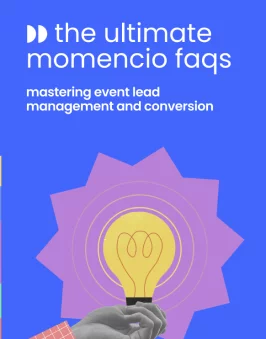
Optimizing lead scoring
To ensure your lead scoring system remains relevant and practical:
- Feedback integration
Actively incorporate sales team feedback to determine how well the scores align with sales readiness. Use this feedback to adjust scores and refine criteria. - Continuous learning and improvement
Create a mechanism for constant learning and model improvement. Update your lead scoring system periodically to adapt to emerging market trends and evolving business strategies. - Automate processes
Leverage marketing automation tools to manage the scoring process and ensure leads are continuously updated and prioritized. - Utilize AI and machine learning
AI and machine learning can predict lead behavior more effectively. Employ these technologies for predictive scoring and deeper analysis of behavioral patterns. - Conduct regular model audits
Audit your lead scoring models periodically to confirm their alignment with business goals. Identify underperforming scores, adjust criteria, and consider new behavioral triggers.
By adopting these optimization techniques, businesses can make lead scoring a more accurate and insightful process that enhances their marketing and sales alignment.
Calculating scoring rate
The scoring rate measures how well your scoring model is performing. A high scoring rate indicates that leads with higher scores are converting as expected, while a low scoring rate shows a disconnect. Here’s how to calculate and improve it:
- Identify conversion goals
Define what conversion means for your business. Is it a meeting with a sales representative, signing up for a demo, or directly purchasing a product? - Analyze historical data
Use historical data to understand how leads with different scores converted. This analysis will help you establish benchmarks for expected conversion rates. - Calculate the scoring rate
Calculate the scoring rate by dividing the number of conversions by the total number of leads in each score bracket. This helps identify scoring categories that are performing well and those that are not. - Refine the scoring system
If specific score brackets are not converting as expected, refine the criteria. Consider lowering scores for attributes that aren’t converting or raising scores for behaviors that align more closely with conversions. - Benchmark and track progress
Establish benchmarks and measure progress periodically. Track the changes in conversion rates after each refinement to ensure continuous improvement.
For those seeking to deepen their understanding of lead scoring within event strategies and explore specific methods for enhancing scoring models, the following continuation is highly recommended:
- 5 Tips: Developing Effective Scoring Criteria for Event Leads: This article delves into practical advice on setting up scoring criteria that are specifically tailored to the dynamics of event marketing. It covers how to evaluate and weigh different types of interactions and demographic factors to optimize lead qualification and prioritization effectively.
Interesting facts from research
- Companies using lead scoring models experience a 77% increase in lead generation ROI.
- Businesses using predictive lead scoring have seen a 40% increase in conversion rates.
- 68% of marketers identify lead scoring based on content engagement as the most valuable.

Conclusion
Lead scoring is a vital methodology that aligns marketing and sales strategies, streamlines lead management and significantly improves conversion rates. By understanding different categories like demographic, firmographic, behavioral, and technographic scoring, businesses can create a more comprehensive and effective lead prioritization process.
An efficient lead scoring system is built on clear criteria, integrates behavioral data, and continuously incorporates feedback loops from sales teams. Collaboration between marketing and sales is critical to refining scoring models, as is utilizing advanced analytics to predict lead behavior and prioritize leads in real time.
The scoring rate is an essential metric that helps businesses measure the effectiveness of their scoring models and make necessary adjustments. By regularly auditing and optimizing lead scoring, companies can stay agile, refine their scoring criteria, and ensure that only high-potential leads are prioritized, reducing wasted time and resources.
Optimized lead scoring provides businesses with a holistic framework to enhance sales and marketing collaboration, better manage leads, and ultimately increase ROI. Prioritizing scoring criteria, incorporating AI tools, and refining models are all essential steps toward crafting a strategic, data-driven approach to lead scoring that delivers remarkable growth and client engagement.
To unlock the full potential of your event marketing efforts, momencio provides an intuitive platform designed to optimize lead management and streamline your sales funnel. Discover how lead scoring can transform your lead management—book a demo today!
FAQs – Lead scoring
- What is the difference between lead scoring and grading?
- Lead scoring is the process of assigning numerical values to leads based on their likelihood of conversion. Grading measures a lead’s suitability according to demographic or firmographic attributes, indicating how well they match the ideal customer profile.
- What is the difference between lead scoring and engagement scoring?
- Engagement scoring focuses on a lead’s interactions with marketing materials, such as email opens, webinar attendance, and content downloads. Lead scoring includes these behaviors but also considers other factors like demographics and purchase history.
- What are the categories of lead scoring?
- Categories include demographic, firmographic, behavioral, psychographic, geographic, and technographic scoring. These categories provide a holistic understanding of leads and their likelihood of conversion.
- How do you build an effective lead scoring process?
- Start with clear scoring criteria aligned with your business goals, incorporate behavioral data, and establish collaboration with sales teams. Refine the model continuously and automate the process with marketing automation tools.
- Is lead scoring a methodology?
- Yes, lead scoring is a methodology that prioritizes leads based on how closely they align with your ideal customer profile and their likelihood of purchasing.
- How do you optimize lead scoring?
- Incorporate feedback from sales, utilize advanced analytics, refine the scoring model regularly, and leverage AI tools for dynamic and predictive scoring.
- How do you calculate the scoring rate?
- Divide the number of conversions by the total number of leads in each score bracket to determine the scoring rate. Use this to refine your scoring system.
